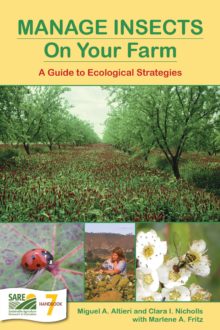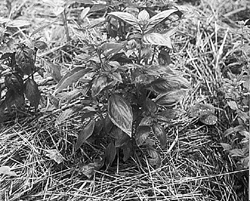
Strategies to Enhance Beneficials
One of the most powerful and long-lasting ways to minimize economic damage from pests is to boost populations of existing or naturally occurring beneficial organisms by supplying them with appropriate habitat and alternative food sources. Beneficial organisms such as predators, parasites and pest-sickening “pathogens” are found far more frequently on diverse farms where fewer pesticides are used, than in monocultures or in fields routinely treated with pesticides.
The following characteristics are typical of farms that host plentiful populations of beneficials:
- Fields are small and surrounded by natural vegetation.
- Cropping systems are diverse and plant populations in or around fields include perennials and flowering plants.
- Crops are managed organically or with minimal agrichemicals.
- Soils are high in organic matter and biological activity and — during the off-season — covered with mulch or vegetation.
To conserve and develop rich populations of natural enemies, avoid cropping practices that harm beneficials. Instead, substitute methods that enhance their survival. Start by reversing practices that disrupt natural biological control, such as insecticide applications, hedge removal and comprehensive herbicide use intended to eliminate weeds in and around fields.
Even small changes in farming routines can substantially increase natural enemy populations during critical periods of the growing season. The simple use of straw mulch provides humid, sheltered hiding places for nocturnal predators like spiders and ground beetles. By decreasing the visual contrast between foliage and bare soil, straw mulch also can make it harder for flying pests like aphids and leafhoppers to “see” the crops they attack. This combination of effects can significantly reduce insect damage in mulched garden plots.
As with most strategies described in this book, multiple benefits accrue from diversification. For example, carefully selected flowering plants or trees in field margins can be important sources of beneficial insects, but they also can modify crop microclimate, add organic matter and produce wood or forage. Establishing wild flower margins around crop fields enhances the abundance of beneficial insects searching for pollen and nectar. The beneficials then move into adjacent fields to help regulate insect pests. As an added benefit, many of these flowers are excellent food for bees, enhancing honey production, or they can be sold as cut flowers, improving farm income.
Increase the population of natural enemies. To an insect pest, a fertilized, weeded and watered monoculture is a dense, pure concentration of its favorite food. Many have adapted to these simple cropping systems over time. Natural enemies, however, do not fare as well because they are adapted to natural systems. Tilling, weeding, spraying, harvesting and other typical farming activities damage habitat for beneficials. Try instead to support their biological needs.
To complete their life cycles, natural enemies need more than prey and hosts; they also need refuge sites and alternative food. For example, many adult parasites sustain themselves with pollen and nectar from nearby flowering weeds while searching for hosts. Predaceous ground beetles — like many other natural enemies — do not disperse far from their overwintering sites; access to permanent habitat near or within the field gives them a jump-start on early pest populations.
CAUTION: Using mulch to increase populations of spiders and ground beetles only works if the pests attacking your crops are prey for those predators.
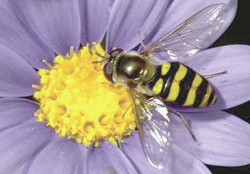
Provide supplementary resources. You can enhance populations of natural enemies by providing resources to attract or keep them on your farm. In North Carolina, for example, erecting artificial nesting structures for the red wasp (Polistes annularis) intensified its predation of cotton leafworms and tobacco hornworms. In California alfalfa and cotton plots, providing mixtures of hydrolyzate, sugar and water increased egg-laying by green lacewings six-fold and boosted populations of predatory syrphid flies, lady beetles and soft-winged flower beetles.
You can increase the survival and reproduction of beneficial insects by allowing permanent populations of alternative prey to fluctuate below damaging levels. Use plants that host alternative prey to achieve this; plant them around your fields or even as strips within your fields. In cabbage, the relative abundance of aphids helps determine the effectiveness of the general predators that consume diamondback moth larvae. Similarly, in many regions, anthocorid bugs benefit from alternative prey when their preferred prey, western flower thrips, are scarce.
Another strategy is to augment the population of a beneficial insect’s preferred host. For example, cabbage butterflies (a pest of cole crops) are the preferred host for two parasites (Trichogramma evanescens and Apanteles rebecula). Supplemented with continual releases of fertile females, populations of this pest escalated nearly ten-fold in spring. This enabled populations of the two parasites — both parasitic wasps — to buildup earlier in spring and maintain themselves at effective levels all season long. Because of its obvious risks, this strategy should be restricted to situations where sources of pollen, nectar or alternative prey simply can’t be obtained.
Manage vegetation in field margins. With careful planning, you can turn your field margins into reservoirs of natural enemies. These habitats can be important overwintering sites for the predators of crop pests. They also can provide natural enemies with pollen, nectar and other resources.
Many studies have shown that beneficial arthropods do indeed move into crops from field margins, and biological control is usually more effective in crop rows near wild vegetation than in field centers:
- In Germany, parasitism of the rape pollen beetle is about 50 percent greater at the edges of fields than in the middle.
- In Michigan, European corn borers at the outskirts of fields are more prone to parasitism by the ichneumonid wasp Eriborus terebrans.
- In Hawaiian sugar cane, nectar-bearing plants in field margins improve the numbers and efficiency of the sugar cane weevil parasite (Lixophaga sphenophori).
- In California, where the egg parasite Anagrus epos (a parasitic wasp) reduces grape leafhopper populations in vineyards adjacent to French prunes, the prunes harbor an economically insignificant leafhopper whose eggs provide Anagrus with its only winter food and shelter.
- According to USDA Agricultural Research Service scientists in Gainesville, Fla., today’s higher-yielding commercial cottons produce volatile chemical signals at only one-seventh the level of naturalized varieties, impairing their ability to recruit natural enemies.
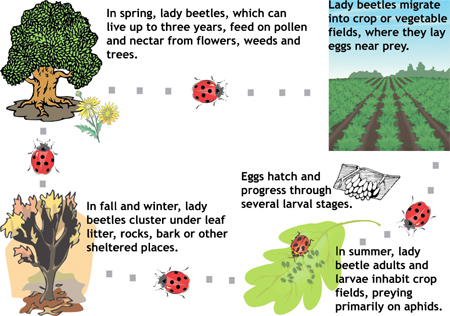
Fortunately, our knowledge of plants’ roles in their own defense is steadily expanding. This knowledge can be used to breed and engineer plants whose defenses work harmoniously with natural systems. More research, as well as plant breeding programs that focus on enhancing natural defenses, are needed. Such programs might emphasize open-pollinated crops over hybrids for their adaptability to local environments and greater genetic diversity.
In Norway’s apple orchards, the abundance of apple fruit moth pests depends largely on the number of berries produced by the European mountain ash (Sorbus aucuparia), a wild shrub. Because only one apple fruit moth larva can develop inside each berry, the number of these pests is directly limited by the number of berries. Thus, when European mountain ash fails to bear, apple fruit moth populations fail as well. Unfortunately, that also spells death for a naturally occurring parasite of the apple fruit moth, the braconid parasitoid wasp (Microgaster politus). Entomologists have advised Norwegian orchardists to plant a cultivated Sorbus (ash) for its regular and abundant crops. By sustaining both apple fruit moths and Microgaster, this practice allows the natural enemies to hold the moths at levels Sorbus can support. The result: the moths don’t abandon Sorbus for orchards.
CAUTION: If you are tolerating or enhancing pest or host populations in order to provide continuing resources for beneficial organisms, be sure to monitor these populations carefully as they can build to economically-damaging levels.
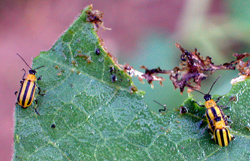
Manage plants surrounding fields to manage specific pests. One practice, called perimeter trap cropping, works best when plants like snap beans or cowpeas are grown to attract stink bugs and Mexican bean beetles away from soybeans. In perimeter trap cropping, plants that are especially attractive to target pests are planted around a cash crop, encircling it completely without gaps.
Perimeter trap cropping can sharply reduce pesticide applications by attracting pests away from the cash crop. By limiting pesticide use in field borders or eliminating it entirely, you can preserve the beneficials in the main crop. Extension vegetable educators at the University of Connecticut report that up to 92 percent of pepper maggot infestation occurs on trap crops of unsprayed hot cherry peppers, effectively protecting the sweet bell peppers inside. Applying pesticide to the trap crop during the flight of the adult pepper maggot fly reduces infestations in the unsprayed bell peppers by 98 to 100 percent. Connecticut commercial growers with low to moderate pepper maggot populations have confirmed the method’s success on fields as small as one-quarter acre and as large as 20 acres.
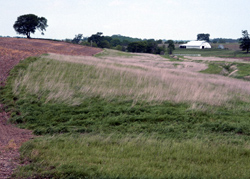
In Florida, researchers with the USDA-ARS found that a collard trap crop barrier around commercial cabbage fields prevented diamondback moth larvae from exceeding action thresholds and acted as a refuge planting to build parasite numbers; cabbage growers who used perimeter trap cropping reduced their insecticide applications by 56 percent. In Ontario, Canada, researchers also found that planting ‘Southern Giant’ mustard around fields of cabbage, cauliflower and broccoli protected them from flea beetles.
Alternately, flowering plants such as Phacelia or buckwheat can be grown in field margins to increase populations of syrphid flies and reduce aphid populations in adjacent vegetable crops. This method is most effective for pests of intermediate mobility. Consider plants that support beneficial insects and can be harvested to generate revenue.
CAUTION:
Field boundary plants that harbor beneficials can go to seed, contaminating field edges with weeds. Mow or plow down these plants before seeds are mature or maintain field margins at a small distance from the field edges to prevent weed problems in your cash crop.
Create corridors for natural enemies. You can provide natural enemies with highways of habitat by sowing diverse flowering plants into strips every 165 to 330 feet (50–100 m) across the field. Beneficials can use these corridors to circulate and disperse into field centers.
European studies have confirmed that this practice increases the diversity and abundance of natural enemies. When sugar beet fields were drilled with corridors of tansy leaf (Phacelia tanacetifolia) every 20 to 30 rows, destruction of bean aphids by syrphids intensified. Similarly, strips of buckwheat and tansy leaf in Swiss cabbage fields increased populations of a small parasitic wasp that attacks the cabbage aphid. Because of its long summer flowering period, tansy leaf has also been used as a pollen source to boost syrphid populations in cereal fields.
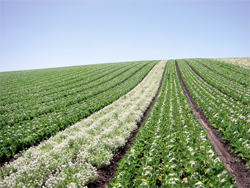
For more extended effects, plant corridors with longer-flowering shrubs. In northern California, researchers connected a riparian forest with the center of a large monoculture vineyard using a vegetational corridor of 60 plant species. This corridor, which included many woody and herbaceous perennials, bloomed throughout the growing season, furnishing natural enemies with a constant supply of alternative foods and breaking their strict dependence on grape-eating pests. A complex of predators entered the vineyard sooner, circulating continuously and thoroughly through the vines. The subsequent food-chain interactions enriched populations of natural enemies and curbed numbers of leafhoppers and thrips. These impacts were measured on vines as far as 100 to 150 feet (30–45 m) from the corridor.
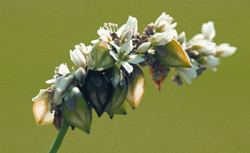
TIP: Sowing diverse flowering plants, such as tansy leaf and buckwheat, into strips that cut across fields every 165 to 330 feet (50–100 m) can provide natural enemies with highways of habitat.
CAUTION: The plants you choose must provide food resources early in the season so that populations of beneficials can build before pests colonize fields. Also, make sure these plants don’t harbor viruses or other diseases or high densities of insect pests.
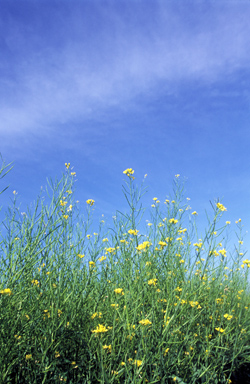
Select the most appropriate plants. Beneficial insects are attracted to specific plants, so if you are trying to manage a specific pest, choose flowering plants that will attract the right beneficial insect(s). The size and shape of the blossoms dictate which insects will be able to access the flowers’ pollen and nectar. For most beneficials, including parasitic wasps, the most helpful blossoms are small and relatively open. Plants from the aster, carrot and buckwheat families are especially useful (Table 1).
Timing is as important to natural enemies as blossom size and shape, so also note when the flower produces pollen and nectar. Many beneficial insects are active only as adults and only for discrete periods during the growing season: They need pollen and nectar during those active times, particularly in the early season when prey is scarce. One of the easiest ways you can help is to provide mixtures of plants with relatively long, overlapping bloom times. Examples of flowering plant mixes might include species from the daisy or sunflower family (Compositae) and from the carrot family (Umbelliferae).
Information about which plants are the most useful sources of pollen, nectar, habitat and other critical needs is far from complete. Clearly, many plants encourage natural enemies, but scientists have much more to learn about which plants are associated with which beneficials and how and when to make desirable plants available to key predators and parasitoids. Because beneficial interactions are site-specific, geographic location and overall farm management are critical variables. In lieu of universal recommendations, which are impossible to make, you can discover many answers for yourself by investigating the usefulness of alternative flowering plants on your farm. Also consider tapping into informational networks, such as Extension, NRCS and nonprofit organizations. Other farmers make great information sources, too (Resources).
TIP: When choosing flowering plants to attract beneficial insects, note the size and shape of the blossoms. For most beneficials, including parasitic wasps, the most helpful blossoms are small and relatively open. Plants from the aster, carrot and buckwheat families are especially useful.
Use weeds to attract beneficials. Sometimes, the best flowering plant to attract beneficials is a weed, but this practice complicates management. Although some weeds support insect pests, harbor plant diseases or compete with the cash crop, others supply essential resources to many beneficial insects and contribute to the biodiversity of agroecosystems.
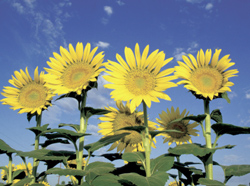
In the last 20 years, researchers have found that outbreaks of certain pests are less likely in weed-diversified cropping systems than in weed-free fields. In some cases, this is because weeds camouflage crops from colonizing pests, making the crops less apparent to their prospective attackers. In other cases, it is because the alternative resources provided by weeds support beneficials.
Unquestionably, weeds can stress crops, but substantial evidence suggests that farmers can enhance populations of beneficials by manipulating weed species and weed management practices. A growing appreciation for the complex relationships among crops, weeds, pests, and natural enemies is prompting many of today’s farmers to emphasize weed management over weed control.
Using weeds in your biological control program will require an investment of time and management skills. First, define your pest management strategy precisely, then investigate the economic thresholds that weeds should not exceed. If you choose to work with weeds in your biodiverse farming system, consider the following management strategies:
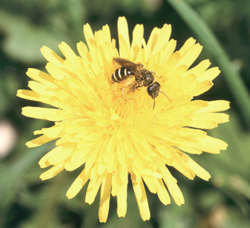
- Space crops closely.
- Limit weeds to field margins, corridors, alternate rows or mowed clumps within fields, rather than letting them spread uniformly across fields.
- Use species sold in insectary plant mixtures.
- Prevent or minimize weed seed production.
- Mow weeds as needed to force beneficial insects into crops.
- Time soil disturbances carefully — for example, plow recently cropped fields during different seasons — so specific weeds can be available when specific beneficials need them.
- Except in organic systems, apply herbicides selectively to shift weed populations toward beneficial weed species.
TIP: When using weeds in your biological control program, first define your pest management strategy precisely, then investigate the economic thresholds that weeds should not exceed.
CAUTION: Using weeds to manage insect pests could create more problems than it solves. Start with small test areas that you can monitor regularly. Observe flowering activity and prevent weeds from going to seed. See additional precautions in this section.
Enhance plant defenses against pests. The first line of defense against insect pests is a healthy plant. Healthy plants are better able to withstand the onslaught of insect pests and can respond by mobilizing inbred mechanisms to fight off the attack. You can enhance natural defenses by improving soil and providing the best possible growing conditions, including adequate (but not excess) water and nutrients.
As plants co-evolved with pests, they developed numerous defenses against those pests. Some of those defenses have been strengthened over time through plant breeding, while others have been lost. Some plant defenses — spines, leaf hairs and tough, leathery leaves — are structural. Others are chemical:
- Continuous, or constitutive defenses are maintained at effective levels around the clock, regardless of the presence of pests; they include toxic plant chemicals that deter feeding, leaf waxes that form barriers, allelopathic chemicals that deter weed growth and other similar defenses.
- Induced responses are prompted by pest attacks; they allow plants to use their resources more flexibly, spending them on growth and reproduction when risks of infection or infestation are low but deploying them on an as-needed basis for defense when pests reach trigger levels.
The most effective and durable plant defense systems combine continuous and induced responses. Under attack by a plant-eating insect or mite, a crop may respond directly by unleashing a toxic chemical that will damage the pest or obstruct its feeding. It may also respond indirectly, recruiting the assistance of a third party.
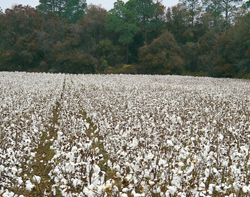
Many plants produce volatile chemicals that attract the natural enemies of their attackers. To be effective, these signals must be identifiable and distinguishable by the predators and parasites whose help the crop is enlisting. Fortunately, plants under attack release different volatile compounds than plants that have not been damaged. Crops can even emit different blends of chemicals in response to feeding by different pests. Different varieties of the same plant — or even different parts or growth stages — can release different amounts and proportions of volatile compounds. Leaves that escape injury also produce and release volatiles, intensifying the signaling capacities of damaged plants.
For example, when a beet armyworm chews on a cotton plant, the plant releases a specific chemical signal blend into the air. Female parasitic wasps pick up this signal and use it to locate the armyworm. They sting the armyworm and lay their eggs inside it, causing an immediate and dramatic reduction in armyworm feeding. This greatly reduces damage to the plant that originated the signal. Interestingly, inappropriate levels of added nitrogen can change the ratio of the molecules that comprise the chemical signal, thereby changing the signal and rendering it unnoticeable by the wasp.

Plant breeding — though overwhelmingly beneficial in the short term — can have unforeseen consequences that unravel the best-laid plans of plant geneticists. Since the focus of plant breeding for pest resistance is often limited to a specific plant/pest interaction, selecting for one resistant gene could inadvertently eliminate other genes affecting other pests or genes that play a role in attracting the natural enemies of the pest.
In addition, newly developed varieties may stand better or yield more at the expense of natural defenses that are often unintentionally sacrificed for those other qualities. Selecting for one trait such as height could mean selecting inadvertently against any one of the many inborn plant defenses against pests. For example:
- Scientists in Texas found that nectar-free cotton varieties attract fewer butterfly and moth pests, as their developers intended; however, as a consequence, these varieties also attract fewer parasites of tobacco budworm larvae and are thus more susceptible to that pest.
TIP: Excess nitrogen fertilizer may hamper cotton’s ability to send a chemical call for help.
CAUTION: Plant varieties are not equal in their abilities to defend themselves: some modern varieties lack the defenses of their native predecessors.
